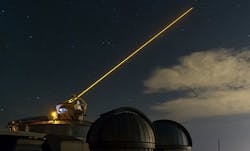Boeing to help Air Force develop space superiority technologies for the control of space
Officials of the Air Force Research Laboratory at Kirtland Air Force Base, N.M., announced a $275 million contract Tuesday to the Boeing Directed Energy and Strategic Systems segment in Albuquerque, N.M., for the R&D for Advanced Space Superiority Technology and Engineering Requirements (RASTER) program.
Boeing will provide research, engineering, and program management for ground-based space-superiority capabilities and technology, and then apply that knowledge to Air Force and U.S. Department of Defense (DOD) space-superiority capabilities.
U.S. space superiority describes the ability of U.S. military forces to use satellites and other space assets anytime and anywhere without enemy interference. It refers to the U.S. military's ability to use satellites and prevent the enemy's access to space.
Boeing's RASTER work will help the Air Space Electro-Optics Division of the Air Force Research Lab develop electro-optical and directed-energy technologies for space superiority.
Related: Military seeks to blend aircraft and sensors to keep air superiority in dangerous airspace
Boeing experts will conduct research on hardware and software; operate Air Force research equipment; perform data analysis, and handle contract management at the Air Force's Starfire Optical Range at Kirtland Air Force Base, and at the Maui Space Surveillance System on Maui, Hawaii.
Boeing research will include dim object detection; tracking and imaging of space objects; high-resolution imaging software and hardware; laser guide stars; improved control systems for advanced adaptive optics (AO); laser communications; modeling atmospheric turbulence; 3-meter class telescope daytime capability; inverse synthetic aperture laser radar; compensated Fourier telescopy; debris characterization; and sensor development.
The overall goals of Boeing's work for the RASTER program are deep space object characterization; space object custody; timely and available space situational awareness; and operations.
On this contract Boeing will do the work at Kirtland Air Force Base, New Mexico; and Maui, Hawaii, and the three task orders are expected to be completed by November 2020.
For more information contact Boeing Directed Energy and Strategic Systems online at www.boeing.com/defense/missile-defense/directed-energy, or the Air Force Research Lab at www.kirtland.af.mil/afrl_de.
